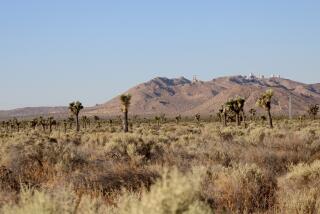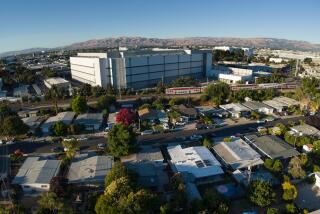Postscript : Solar Farm Has Yet to Reach Full Power
- Share via
WARNER SPRINGS — When a 30-acre electricity farm was constructed here 18 months ago, there were suggestions that the solar energy industry was about to come of age.
The La Jet Energy Co. of Abilene, Tex., one of a handful of companies across the United States investing in solar energy research in a big way, hoped that its field of 700 solar concentrators, pointing upward like so many giant sunflowers, would not only help generate electricity but actually become a source of profit.
Until then, a handful of companies had found several ways of turning solar energy into electricity, but none had found it profitable for investors.
La Jet hoped at the time that its $18.7-million facility would pay off because its state-of-the-art solar reflectors--reflective film mirrors that collect sunlight and concentrate it on receivers to heat water--were effective, yet lightweight and inexpensive. That issue--inexpensive solar collectors--was one of the keys if the fledgling industry was to mature as a corporate money-maker, La Jet said.
To ensure that the five-foot-diameter reflectors were capturing as much sunlight as possible, pods of 24 each were installed atop 27-foot-tall structures, which, with the assistance of a master computer and small motors, track the sun from dawn until dusk.
The reflectors would direct the sunlight onto containers of salt solution, heating it to more than 650 degrees. Water piped through the solution and heated into steam is carried back to turbine generators, where the electricity is produced.
Today, La Jet’s facility is not yet turning a profit. In fact, the solar facility is not even reaching its initial projections of producing 3.6 megawatts per hour of electricity. On the best of days, the plant has produced 2.2 megawatts, the company says.
But as a prototype, the plant is performing well and is being fitted with new equipment expected to raise electrical output, said Wayne Adams, director of operations. The work is expected to be completed by the end of the year.
“There is still a lot to learn in this business, including how to improve heat storage, cut down on heat transfer with better insulation of pipes, and generally make it all more efficient,” he said. “And we’re still improving the technology on the mirror itself.”
Solar energy engineers from China, Taiwan, Egypt and Israel have made return visits to the facility here to inspect the hardware and its application, Adams said, because the facility is unique.
For a while, there was consideration given to burning wood, paper and other products in a sophisticated furnace, as a supplemental source of energy to drive the steam turbines. But the company withdrew the proposal because of complaints that it would harm the area’s environment.
“We recognize it (the so-called biomass burning) as a technology which people are not yet aware of,” Adams said. “We’re no longer pursuing that idea. We’re focusing our efforts totally on solar technology.”
So far, the facility has generated about 500,000 kilowatt hours of electricity. That power has been sold to San Diego Gas & Electric Co., which is required by federal law to buy electricity from alternative energy sources as a way to promote the development of those new technologies.
Adams said one other component of solar energy is beyond the company’s technology. “We would like there to be 365 days a year of sunshine, but that seems to be out of our control,” he said.
More to Read
Inside the business of entertainment
The Wide Shot brings you news, analysis and insights on everything from streaming wars to production — and what it all means for the future.
You may occasionally receive promotional content from the Los Angeles Times.










